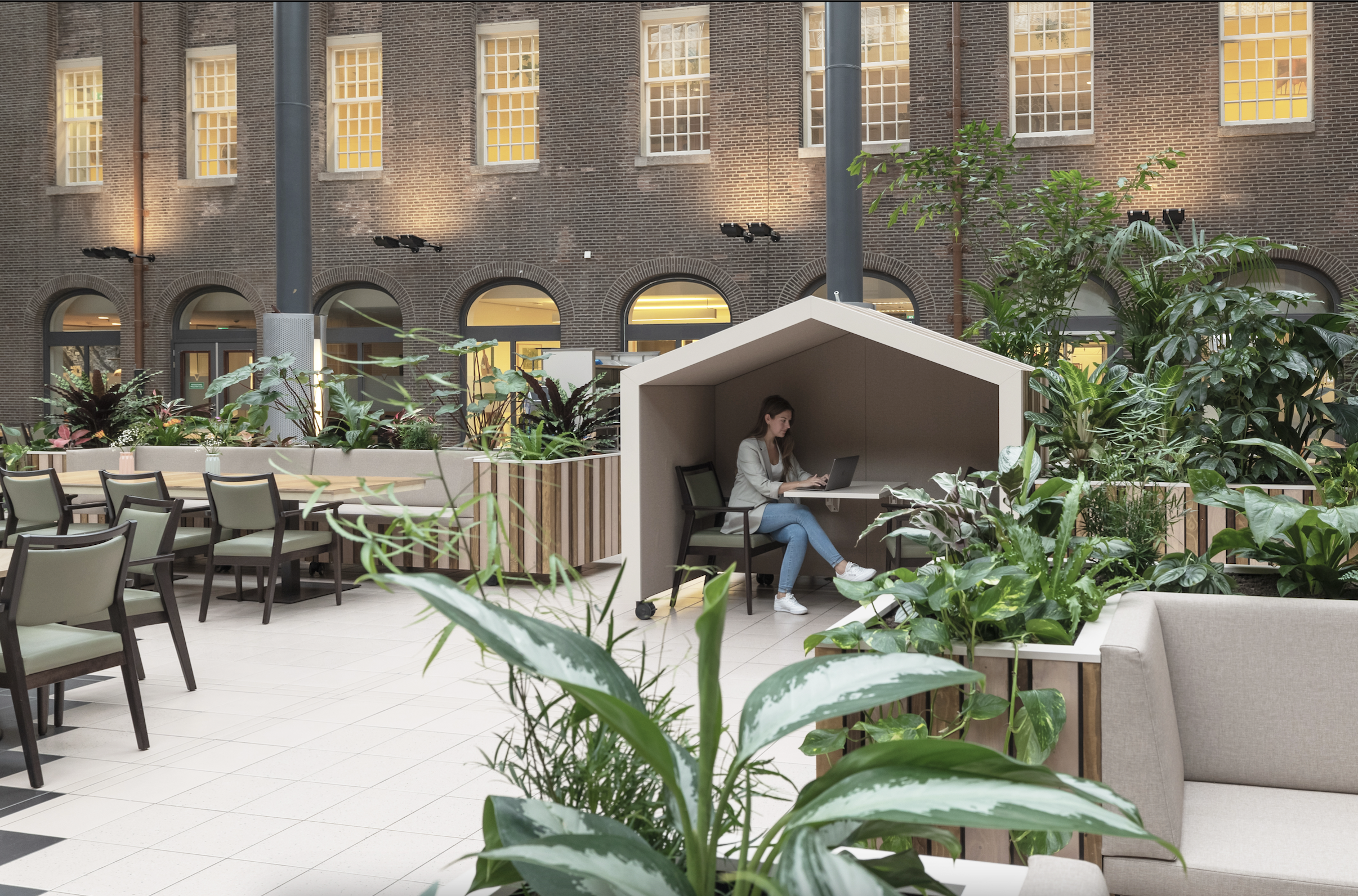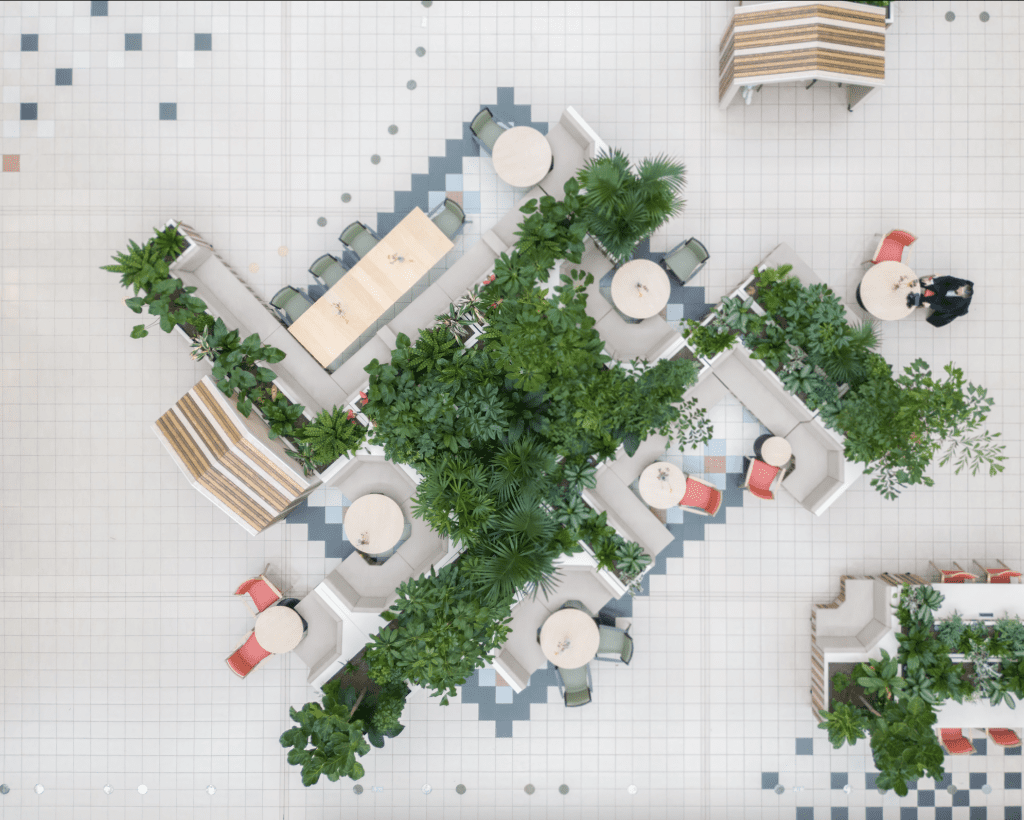

26 Feb Designing Circular, Sustainable, and Modular Spaces in Elder Care
Author: Lauryn Burnes
Keywords: Circular design in elder care, sustainable healthcare design, biophilic design in nursing homes, modular furniture for healthcare, flexible elder care spaces, adaptive healthcare environments, sustainability in senior living, green design in nursing homes, Dr. Sarphatihuis project, MOSS biophilic design, modular furniture, recycled materials in design
Introduction: Innovating
Elder Care
The intersection of sustainability and elder care presents an opportunity to redefine how we design spaces for aging populations. Biophilic and adaptable design can significantly improve the quality of life for elderly individuals, particularly in care settings where comfort, accessibility, and well-being are of utmost importance.
In 2022, MOSS worked on a project at Dr. Sarphatihuis in collaboration with circular furniture company, Furnify, who merged with D/DOCK in January 2025. This project saw the transformation of a historic elder care facility in Amsterdam into a multifunctional, healing space that encourages connection, adaptability, and a stronger link between people and nature. In a conversation with Sabrina van Dongen, former Managing Director at Furnify, we explored how circularity and biophilic design can transform and improve the care environment for both employees and residents.


Project and Module Overview
Sustainability was a key priority in the Dr. Sarphatihuis project, with a strong emphasis placed on circularity. In collaboration with Amsta, D/DOCK, Nook, and Intos, MOSS and Furnify developed modular planters. These are called “Moving Islands”, and they were created using predominantly recycled materials. The modules stand as both furniture and planters on wheels, allowing residents and employees to arrange and re-arrange the interior layout of the atrium however they please. This creates a dynamic and flexible environment which can be used multi-functionally. This allows the space to adapt to various uses—from intimate gatherings to larger events. Beyond introducing a biophilic and flexible element to this design, the intention that went into creating these modules is closely tied to sustainability due to their composition in alignment with circular design principles.
Circularity in Action: Giving Waste New Life
Circular design is a crucial strategy for reducing environmental impact, shifting away from the wasteful “take-make-dispose” model. Instead, we aspire to a more regenerative approach. Furnify, a part of D/DOCK, embodied this philosophy by repurposing wood waste from interior builders. They transformed discarded materials into high-value products rather than sending them to the shredder.
“Instead of treating leftover materials as waste, we use them as resources,” said Sabrina.
This approach was central to the redesign of Dr. Sarphatihuis, where recycled materials were used to create the adaptable Moving Islands, proving that sustainability can be both functional and beautiful.
“We wanted to offer a solution for wood waste streams. So we went to interior builders to see what their waste streams are at the moment, and there are a lot of leftover little pieces of wood. With all the leftovers we made sleds from them and we were able to make the product that we wanted.”
The impact of these choices goes beyond environmental benefits—by making sustainability visible, the space tells a story of renewal and responsibility, reinforcing the idea that elder care environments can be designed with both people and the planet in mind.
Modularity and Adaptability: The Moving Islands Concept
The Moving Islands concept at Dr. Sarphatihuis redefined how elder care spaces can function, introducing modular furniture that enhances usability without sacrificing stability. These adaptable units—on wheels and easily reconfigurable—allow the atrium to shift seamlessly between an open event hall and smaller, intimate gathering spaces.
“The beauty of this system is that it adapts to the needs of the residents,” says Sabrina. “It really contributes to a positive vibe and a nice atmosphere… It opens so many possibilities for the people within; you could have a co-working space and then a couple hours later do a dance show and in the evening have a dinner event.”
It also allows for integrated greenery, which further enriches the ambiance, softening the space visually while promoting well-being with a biophilic approach. By combining flexibility with thoughtful design, the Moving Islands ensure that functionality and comfort coexist, creating an environment that truly supports its residents.
The Need for Flexible Spaces in Elder Care Facilities
Traditional elder care environments often struggle with static, inflexible layouts that limit social interaction and adaptability to residents’ changing needs. This lack of flexibility can contribute to isolation and hinder well-being. As Sabrina explained,
“Many care facilities are designed with fixed spaces that don’t accommodate different activities or allow for spontaneous social time, which is essential for individuals in that stage of life. By introducing greenery, adaptable furniture, and a more dynamic layout, we created a space that can serve multiple functions—whether as a gathering place, a quiet space, or an event setting.”
This shift reflects a growing recognition that elder care environments must be designed for both function and human connection.
Creating Community: The Social Impact of Modular Spaces
The Moving Islands at Dr. Sarphatihuis do more than just reshape the physical space—they add a sense of community. By enabling the atrium to transform effortlessly, these modular units create opportunities for engagement, from children’s plays and interactive workshops to social games and live performances.
“Having a space that changes means there’s always something new to experience.”
For elderly residents, this variety is vital, as it stimulates cognitive function and combats feelings of isolation. The flexibility of the Moving Islands ensure that the environment remains lively and inviting, encouraging social interaction and reinforcing a sense of belonging.
The success of the Moving Islands concept at Dr. Sarphatihuis highlights its potential for broader applications in hospitals and other healthcare settings. Traditional medical environments often struggle with rigid layouts that limit functionality, but modular and adaptable furniture offers a solution. By maximizing square meters, blended-use spaces can serve multiple purposes throughout the day—transforming from a waiting area to a therapy room or from a communal gathering spot to a quiet retreat.
“Flexibility in healthcare design isn’t just about efficiency; it’s about creating spaces that adapt to human needs,” said Sabrina.
Incorporating greenery and modular elements in hospitals could enhance patient recovery, support social interaction, and contribute to overall well-being, just as it has in this atrium.
Conclusion
In the Dr. Sarphatihuis project, sustainability, circularity, and modularity emerged as essential tools for designing spaces that are not only functional but also compassionate and adaptable. By incorporating these principles, we’ve created an environment that encourages both well-being and human connection, making it a model for the future of elder care. The Moving Islands concept, with its emphasis on flexibility and circularity, shows the power of innovative thinking in transforming healthcare environments.
Looking forward, there is a growing opportunity to integrate this approach into more healthcare settings, where adaptable, sustainable spaces can support the diverse needs of patients, caregivers, and communities alike. By expanding the use of modular and biophilic design, we can redefine the way we care for our elderly, enriching lives and environments with thoughtful, sustainable choices.






